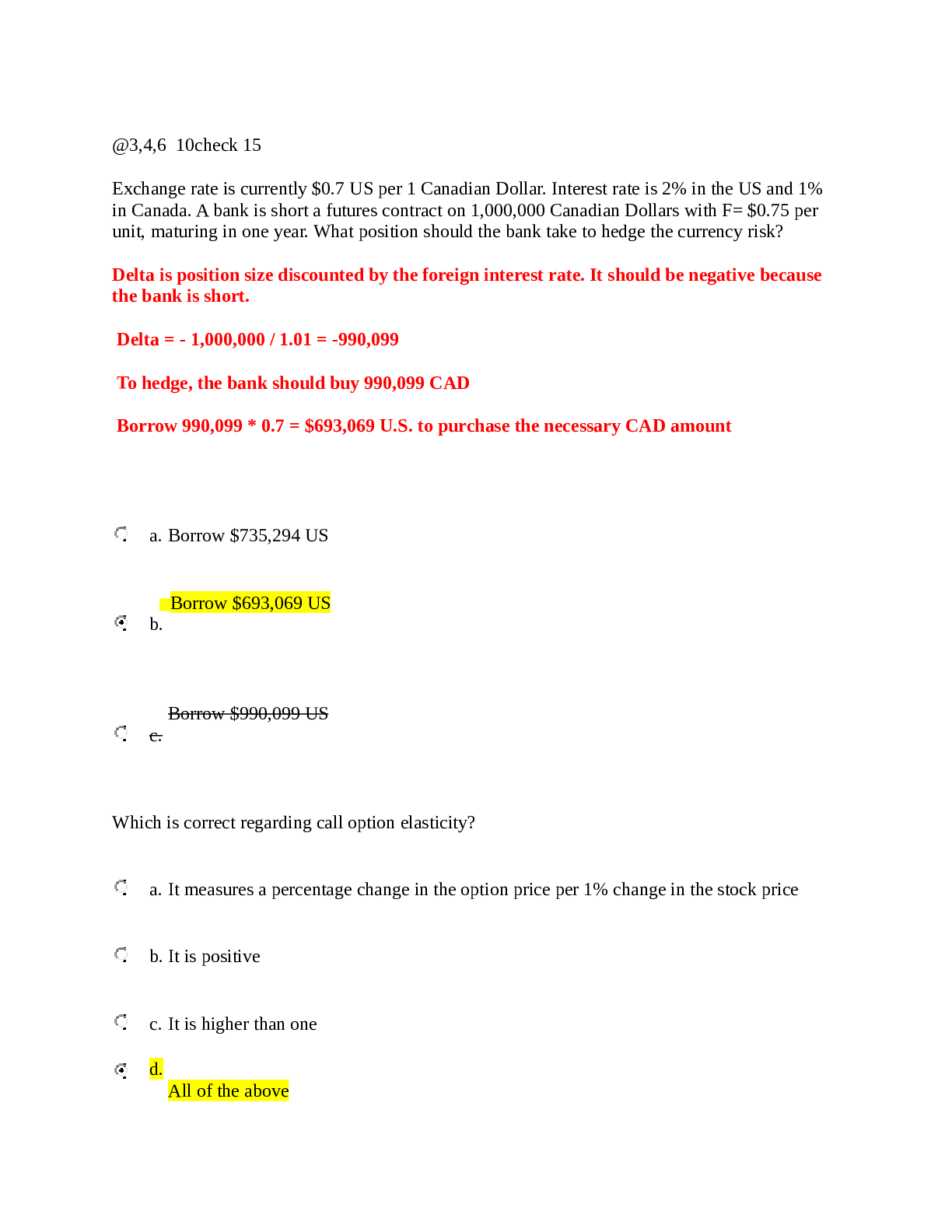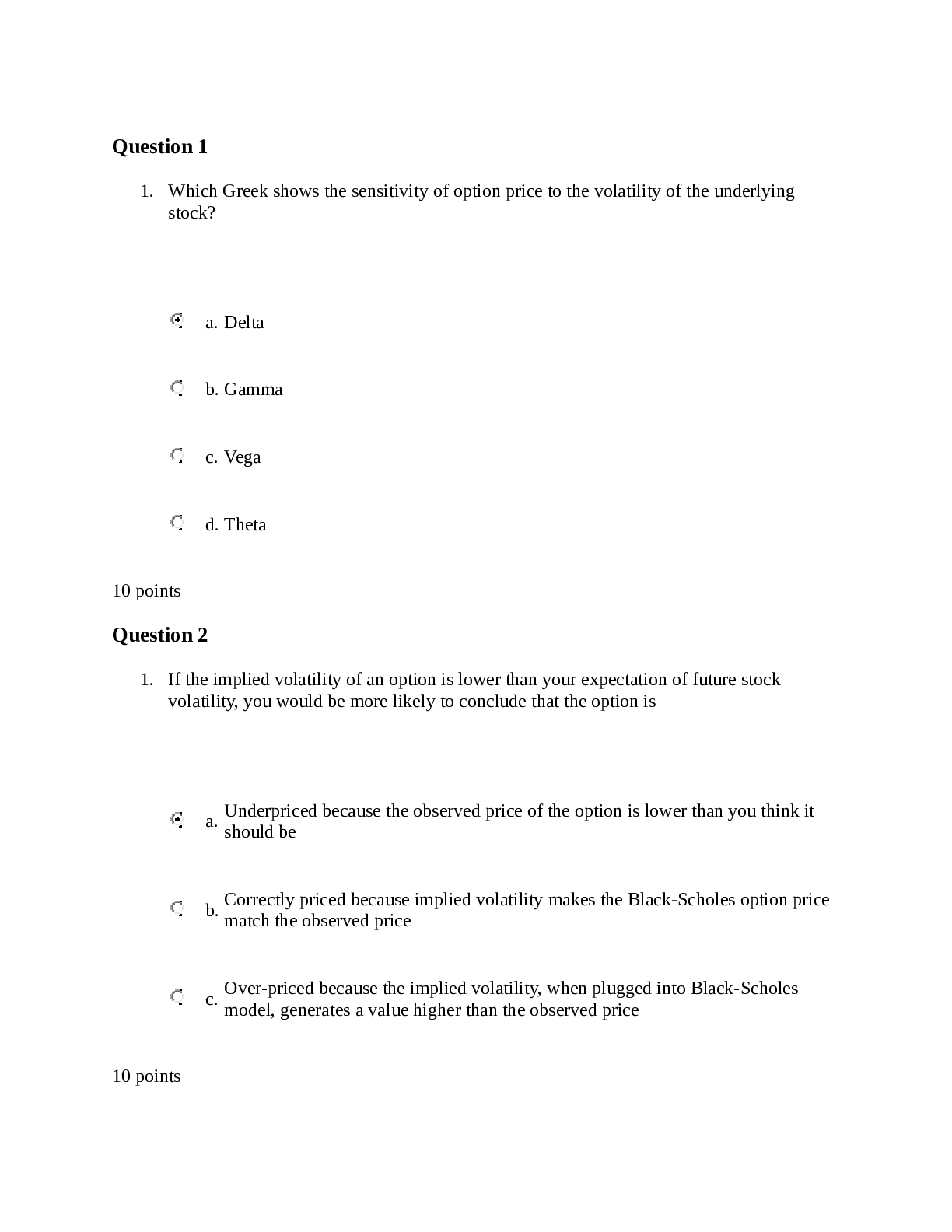Finance > QUESTIONS & ANSWERS > Corporate Tax Final Exam Prep 2022 with complete solution. 2022/2023, Rated A (All)
Corporate Tax Final Exam Prep 2022 with complete solution. 2022/2023, Rated A
Document Content and Description Below
Corporate Tax Final Exam Prep 2022 with complete solution Question 2 Family Stock Attribution Rules... (ch 6)>> ... What is stock redemption->> when a corporation acquires its stock from a shareho... lder in exchange for cash or other property. To qualify for sale or exchange treatment, a stock redemption generally must result in what?>> A substantial reduction in the shareholders ownership interest in the corporation. In determining whether a stock redemption has sufficiently reduced a shareholders interest, what information must be examined?>> If the stock owned by certain related parties is attributed to the redeeming shareholders. (if so, their ownership may not have been reduced adequately) Attribution Rules->> the application of constructive ownership rules to assign to one taxpayer the interest of another taxpayer. Under the attribution rules, what family members are considered to be related parties? "An individual is deemed to own the stock owned by his or her:">> Spouse Children Grandchildren Parents (2 tiers Down) (1 tier up) Quiz Question: Old Grandad founded family corp and still owns 75% of the stock. The rest is owned by you and your 4 siblings individually ( you each own 5%). Applying family attribution rules, what percentage are YOU treated as owning and why?>> You, the grandson, own 5%. You own 5% because an individual is only attributed ownership of stock they dont directly own, if the related party in ownership of the stock is a spouse, child, grandchild, or parent. In this case, your grandparent owns 75%. Attribution rules do not apply to you. Question 32-2D Net Capital Loss.... What can a corp do with net capital losses?>> .... How do capital gains and losses occur?>> as a result of the taxable sale or exhcange of capital assets. What is the netting procedure for capital gains/losses.>> Short term gains net with short term losses. Long term gains net with long term losses. (If both short term and long term create loss/gain, no additional netting required.) (If one is a gain, and the other a loss, further netting is done against each to get a single figure) What can net capital losses offset for corporations?>> They can only be used to offset capital gains. Can corps offset net capital losses against ordinary income?>> NO!, they can only deduct against capital gains. What are the carryback rules for corps?>> They must carry back net capital losses to three preceding years, applying them first to the earliest year in point of time. (they cannot start in the current year) What are the carry forward rules for corps?>> Carry forwards are allowed for a period of 5 years from the year of the loss. When carried back or forward, a long term capital loss is treated as what?>> as a short term capital loss. See example 13 in text. See quizzes. Question 4. Dividends Received Deduction (DRD)>> ... What is the purpose of the DRD?>> it is to mitigate multiple taxation of corporate income.What would occur without the DRD?>> income paid to a corp in the form of a dividend would be taxed to the recipent corp, with no cooresponding deduction to the distributing corp. Later when the receipient ccopr paid the income to its shareholders, the income would again be taxed with no corresponding deduction to the corp. (simple double taxation) What does the amount of the dividends received deduction depend on?>> It depends on the % ownership. (voting power and value) the receipent corp shareholder holds in a DOMESTIC CORPORATION making the dividend distribution. Percentages of ownership by corporate shareholders: -less than 20% -20% or more, less than 80% - 80% or more. What is the deduction percentage allocated to each of the above groups?>> - 70% -80% -100% Can the DRD exceed the taxable income limitation?>> No. Whta is the taxable income limitation?>> it is a limitation equal to the corps taxable income multipled by the percentage that corresponds with the deduction percentage. What are simple steps in determining the taxable income limitation for DRD?>> 1- multiply the dividends received by the deduction percentage 2- multiply the taxable income by the deduction percentage 3- the deduction is limited to the lesser of step 1 or 2, unless deducting the amount figured in step one results in an NOL. If so, step 1 figure is used. See example 26 in the text for practice computing DRD.>> .... How long does a corp need to own stock in the distributing corporation in order to receive the dividends received deduction?>> 45 days. What is the general rule when a corporatin finances a dividend paying stock?>> the DRD is reduced with respect to any dividend paying stock by the percentage of investment that is aquired using financing.What is the reduction in the DRD due to financed stock purchases limited to?>> DRD reduction cannot exceed the amount of the interest deduction allocable to the dividend... (you can either deduct through interest expense deduction, or dividend received deduction. If your DRD is reduced, it wont be reduced more than the amount not covered by the interest expense reduction) When a corporation owns debt-financed portfolio stock, which benefit does the code reduce? - interest deduction on the debt - the Dividends received deduction itself?>> The DRD itself. Question Five. What does Sec. 351 deal with?>> ...Contributions to corporations What sections allow for the nonrecognition of gain or loss?>> -Sec 1031 like kind exchanges -Sec 351 (transfers of property to controlled corps) How long is non-recognition permitted? (what triggers recognition in a transaction that was classified as non-recognizeable)>> Recognition Is postponed until a substantive change in teh taxpayers investment occurs. (sale of property or ownersship shares) What type of corporations do sec 351 deal with?>> contributions to CONTROLLEd corporations. what does sec 351 say?>> says that gain or loss is not recognized upon the transfer of property to a corporation in exhcange for stock. (if cash or boot is received, all or some of that portion will be recognized) What tax concept allows for sec 351 treatment to occur?>> wherewithal to pay concept. How else does congress justify sec 351 treatment?>> they beleive that tax rules should not impede the choice of corporate form of doing buisness. What are the 3 requirements that must be met in order for nonrecognition of gain or loss under sec 351?>> 1- property is transferred 2- in exchange for stock 3- the property transferors are in control of the corporation after the exchange.What is the control requirement that must be satisfied in regard to nonrecognition of gain or loss under sec 351?>> THe transferor of the PROPERTY, must be in control of the corporation immediately after the exchange. How is the control requirement determined?>> Transferors of property must own 80% of all voting stock in the corporation, and at least 80% of the total number of shares of all other classes. (see question 3 on quiz 2) (this will be on final) Basis Determination and Related issues.... (this is the important part of question 5)...>> .... What is the basis in the stock provided to the transferor of property to a corp?>> Substitued basis. What does substituted basis mean?>> the taxpayers basis in the stock is the same as the basis the taxpayer had in the transferred property, (decreased by boot receieved, boot valued at FMV whether cash or property) When property is contributed by a shareholder to a corporation, what is the corporations basis in that property?>> Carryover basis. What does carry over basis mean?>> The corps basis in the property is equal to the transferors basis, plus the amount of any gain recognized on the transfer by the shareholder. What is the basic template for calculate shareholder's basis in transferred property under sec. 351?>> Adjusted basis of property Transferred + gain recognized - boot received (including liability transferred) - adjustment for loss property (if applicable) = shareholder's basis in stock. WHat is the basic template for calculating corps basis in transferred property under sec 351?>> Adjusted basis of property transfereed + Gain recognized by shareholder - adjustment for loss property = Corp's basis briefly explain a built in loss situation when contributing property to a corp?>> shareholder contributes property with a basis that is higher than FMV.Anti loss duplication requires the basis in the property be stepped down by allocating the built in loss among the assets. Are interests that are exchanged for services taxable to a corp?>> No. Are interests paid as consideration to someone for providing services deductible by the corp as business epxneses?>> Yes, unless expense is characterized as a capital expenditure. See chapter 4-1F for practice on basis problems. It should be pretty basic on the exam.>> ..... Question 6 Ch4-2B The (re)classification of issued Debt & Equity.>> ... What are some of the advantages of Debt over equity?>> Interest payments on debt are deductible. Loan repayments to investors are not taxable, unless payment exceed basis. When will teh IRS contend that debt is a actually an equity interest and deny the corp the tax advantages of debt financing?>> When teh corp is thinly capitalized. WHen does thin capitalization exist?>> WHen the shareholder debt is high relative to shareholder equity. If the debt instrument has too many features of stock. What is the implication of debt being treated as stock?>> principal and interest payments will be considered dividends. (non-deductible) What type of corporations do reclassification of debt to equity most concern?>> closely held corps. See bottom of 4-2B for considerations between debt and equity..>> ... (professor said know the rules, but there are not really any rules covered...) Question 7 E&P...>> ...When a positive balance exists in both the current and accumulated E&P accounts, corporate distributions are deemed to be made first from where, then where?>> Current E&P, then from Accumulated E&P. When does it become necessary to allocate current E&p and Accumulated E&P to each distirbution made during the year?>> When distributions exceed the amount of current E&P. What is the first step in allocating current E&P to a distribution?>> Current E&P Allocated to a distirbution= Current E&P x (Amount of Distribution/ Total Dstritbutions) What is the next step after current E&P is allocated to a distibrution?>> Accumulated E&P is applied in a chronological order, beginning with the earliest distribution. See Example 9 in text book on an E&P problem.>> ... If there is a deficit balance in Accumulated E&P, but current E&P is positive, what is the treatment of the distribution?>> No netting. The distribution is deemed to be a taxable dividend to the extent of the positive current E&P balance. When a deficit balance exists in current E&P, but a positive balance exists in accumulated E&P, what is the treatment of the distribution?>> the accounts are netted at date of distribution. In the above situation, if the resulting balance of the netting procedure is 0 or negative, what is the distribution considered to be?>> A return of capital. In the above sitiuation, if teh result of the netting is a positive balance, what is the distribution considered?>> the distribution is a dividend to the extent of the positive balance. Practice the E&P stuff. See quiz 3>> ... Question 8 Basics of calculating E&P from taxable income.>> Question 10 SEc. 162. What does sec 162 relate to?>> Limitation of deductibility for executive salaries. What does sec 162 limit?>> the deductibility of exective compensation.What is the sec 162 limitation.>> Deductible compensation to CEO and other top 4 most highly paid officers is limited to 1 million dollars. Question 11 Sec 761F What does this section cover?>> Qualified Joint Ventures What does sec 761F state?>> That husband and wife who file a joint return for the taxable year, will not be treated as a partnership. How are income gain losses deduction and credits divided between husband and wife under 761F>> Equally based on their respective interests in the venture Who are the only members of a qualified joint venture?>> h [Show More]
Last updated: 2 years ago
Preview 1 out of 21 pages

Buy this document to get the full access instantly
Instant Download Access after purchase
Buy NowInstant download
We Accept:

Reviews( 0 )
$8.00
Can't find what you want? Try our AI powered Search
Document information
Connected school, study & course
About the document
Uploaded On
Sep 22, 2022
Number of pages
21
Written in
Seller

Reviews Received
Additional information
This document has been written for:
Uploaded
Sep 22, 2022
Downloads
0
Views
199























